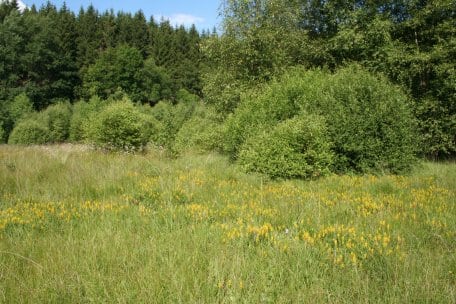The outposts of the High Fens
In the Wahlerscheid district, located in the southern, more elevated areas of the Eifel National Park, you can find small marshlands and bogs. Together with other small moorlands in the National Park’s surroundings (e.g. Wollerscheider und Hoscheider Venn near Simmerath-Lammersdorf and Mützenicher Venn near Mützenich, on the German-Belgian border), they represent the offshoots of the large High Fens upland moor in the neighbouring country of Belgium. The raised and intermediate bogs only develop in places featuring low-nutrient soils and very high rainfall of over 1,000 millimetres per annum. Special mosses (peat bogs) become established here and swamp out almost all other plants. They grow taller and a layer of slowly decaying plant substance, which gradually turns into peat, is created. This causes the layer of vegetation to continue to move away from the mineral substrate and thus from the groundwater. Eventually, the plants become dependent on the low-nutrient rainwater for their water and nutrients. Furthermore, peat bogs acidify the surrounding environment by leaking acids.
Intermediate bogs are those moorlands located between very low-nutrient and acidic raised bogs and the nutrient-richer fens. Besides the layers of peat bog, wetlands with erica (so-called bell heather), sedge reed and moor birch forests can be found here. Like all extreme locations, raised and intermediate bogs are distinguished by a special flora and fauna. A variety of endangered species live in these moorlands and they require special conservation measures. As a result, and due to the neighbouring location to equally valuable grassland biotopes, they represent part of the management zone of the Eifel National Park.

